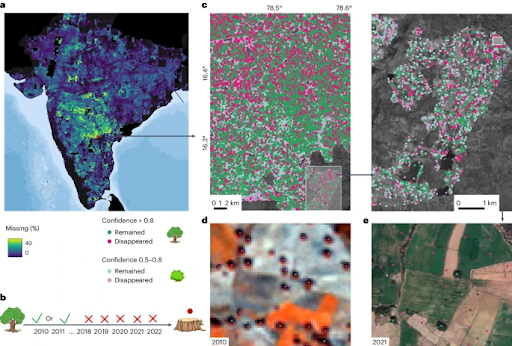Featured paper: Severe decline in large farmland trees in India over the past decade

Authors: Martin Brandt, Dimitri Gominski, Florian Reiner, Ankit Kariryaa, Venkanna Babu Guthula, Philippe Ciais, Xiaoye Tong, Wenmin Zhang, Dhanapal Govindarajulu, Daniel Ortiz-Gonzalo & Rasmus Fensholt
Agroforestry practices that integrate multifunctional trees within agricultural landscapes can generate a range of socioecological benefits, while also serving as a natural climate solution due to their carbon sequestration potential. These trees form a vital part of India’s landscapes. This study focuses on how agroforestry systems in India have transformed over the last decade.
Nationwide mosaics for RapidEye for 2010 and 2011 (5 m resolution) and for PlanetScope (3 m resolution) for 2018, 2019, 2020, 2021 and 2022, along with a large corpus of tree labels for PlanetScope (about 130,000 labels) and RapidEye (about 100,000 labels) forms the basis of the study. Since RapidEye is unreliable in identifying small trees, the study focused on large and mature trees, which can be detected with high confidence (>0.8)) in these images. Deep learning models inspired by the object counting literature were used to detect trees via heatmap-based methods, transforming discrete point labels into continuous Gaussian kernels to enable smoother optimization.
If a tree crown center was visible in the early period (2010/2011) but absent in the later period (2018–2022), it was classified as having disappeared. The results show that 11 ± 2% of high-confidence trees mapped in 2010 or 2011 were no longer present in the 2018–2022 imagery. Several hotspot areas lost up to 50% of their large farmland trees, with as many as 22 trees per square kilometre disappearing. Focusing on the period from 2018 to 2022, 5.3 million trees (2.7 trees per square kilometre) observed in 2018/2019 were not detected in 2020–2022.
To understand the drivers of this change, they conducted interviews with villagers from Telangana, Haryana, Kerala, Maharastra, Andrah Pradesh, Uttar Pradesh, and Jammu and Kashmir. Alterations in cultivation practices, such as the establishment of new boreholes and expansion of paddy rice fields with the objective of boosting crop yields, were identified as an important factor in the rapid decline of agroforestry trees. While all interviewees reported that native trees within fields have become rare, several reported that block plantations have increased, highlighting the rapidly changing farming practices in India.
